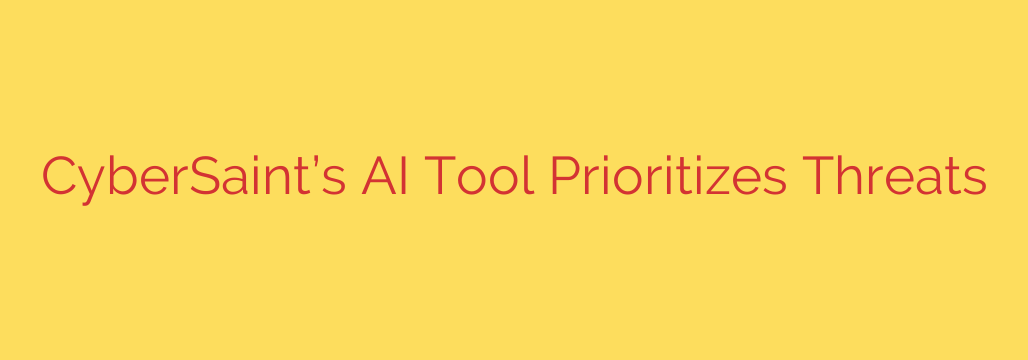
Beyond the Noise: How AI is Revolutionizing Threat Prioritization
In today’s complex digital landscape, security teams are facing a relentless deluge of alerts. From vulnerability scans and intrusion detection systems to threat intelligence feeds, the sheer volume of data is overwhelming. This constant flood leads to a critical problem known as “alert fatigue,” where security analysts become desensitized to warnings, making it nearly impossible to distinguish genuine threats from background noise.
The core challenge isn’t a lack of data; it’s a lack of context. A traditional vulnerability scanner might flag a thousand potential issues, but it can’t tell you which ten pose an existential threat to your most critical business operations. Security teams are left asking the same frustrating question: with limited time and resources, what do we fix first?
The Flaw in Traditional Prioritization
For years, organizations have relied on manual processes and generic scoring systems, like the Common Vulnerability Scoring System (CVSS), to prioritize threats. While useful, these methods have significant limitations:
- Lack of Business Context: A high CVSS score on a non-critical test server is far less urgent than a medium-score vulnerability on your primary e-commerce database. Traditional methods struggle to make this crucial distinction.
- Static and Reactive: Risk scores are often static and don’t account for real-time changes in the threat landscape, such as a new exploit being actively used in the wild.
- Labor-Intensive: Manually correlating threat data with internal asset information is a slow, error-prone process that simply cannot keep up with the speed of modern attacks.
This reactive approach leaves organizations constantly playing catch-up, fixing problems after they’ve been identified without a strategic view of their overall risk posture.
Enter AI: A Smarter Approach to Cybersecurity Risk Management
A new generation of security platforms is leveraging Artificial Intelligence (AI) and machine learning to solve the prioritization puzzle. Instead of just presenting raw data, these intelligent systems act as a powerful analytical engine, connecting the dots between vulnerabilities, threats, and their potential business impact.
By continuously ingesting data from dozens of sources—including scanners, firewalls, threat feeds, and asset inventories—AI can build a dynamic, comprehensive picture of an organization’s unique risk landscape.
The key benefits of this AI-driven approach are transformative:
- Focus on What Truly Matters: AI algorithms correlate technical vulnerabilities with the business criticality of the assets they affect. This means security efforts are automatically directed toward the threats that pose the greatest risk to revenue, reputation, and operations.
- Dramatically Reduce Alert Fatigue: By filtering out the noise and low-impact alerts, AI allows security teams to concentrate their efforts. Instead of chasing thousands of meaningless alerts, analysts can focus on a manageable list of high-priority, contextualized risks.
- Provide Actionable, Justifiable Insights: AI-powered systems don’t just flag a problem; they can explain why it’s a problem. By showing how a specific vulnerability could be exploited and what business function it would impact, these tools empower security leaders to justify resource allocation to executives and the board.
- Align Security with Business Goals: This technology bridges the long-standing gap between the security team and the rest of the business. Risk is no longer an abstract technical concept but is framed in terms of business impact, fostering a more collaborative and effective security culture.
Actionable Steps to Improve Your Threat Prioritization
While adopting an advanced AI platform is a powerful move, any organization can take immediate steps to improve its risk management strategy.
- Develop a Comprehensive Asset Inventory: You cannot protect what you do not know you have. Maintain a detailed and up-to-date inventory of all hardware, software, and data assets.
- Define Business Criticality: Work with department leaders to map your assets to critical business processes. Understand which systems support your most vital functions and classify them accordingly.
- Integrate Threat Intelligence: Ensure your security operations are informed by reliable threat intelligence feeds. Knowing which vulnerabilities are being actively exploited by attackers adds crucial context.
- Adopt a Risk-Based Mindset: Shift the security conversation from “patching everything” to “fixing the most important things first.” Use a combination of technical severity, threat intelligence, and business criticality to guide your remediation efforts.
The Future is Proactive, Not Reactive
The cybersecurity landscape will only grow more complex. Organizations that continue to rely on manual, reactive security measures will inevitably fall behind. By harnessing the power of AI to gain context and prioritize intelligently, security teams can finally move beyond the noise. This allows them to transition from a state of being constantly overwhelmed to one of strategic control, ensuring that their limited resources are always focused on protecting what matters most.
Source: https://www.helpnetsecurity.com/2025/08/04/cybersaint-ai-powered-findings-management/








